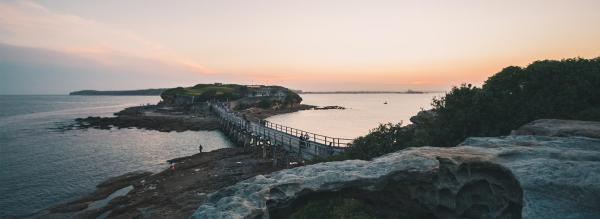
Telling Stories – Digital Learning in La Perouse
At La Perouse Public School books are used to connect kids with local culture and environment. But it’s a creative mix of technology and face-to-face storytelling that really brings them and the school community to life.

Darrall Thompson,
Adjunct Fellow, School of International Studies and Education
Profile page
With a rustle of paper, the stop motion video begins.
‘Many, many years ago, before human time, there was a group of animals,’ explains a child as a picture of a bird appears on screen. From there, a series of young speakers tell the story of the cranes, Garnargan (Koala), a starfish, kookaburra and Burri Burri (humpback whale) and his canoe.
Created by kids from La Perouse Public School, the animation is part of Sharing Our Stories, an innovative approach to learning developed by teachers at the school with input from the La Perouse community and UTS education researcher, Darrall Thompson.
Discovering history, finding pride
The suburb of La Perouse is unique in the Sydney context. Perched on the peninsular above Botany Bay and surrounded by waterways, beaches and national park, it is home to one of the largest Aboriginal communities in the city.
It’s also the site of one of the state’s oldest public schools – La Perouse Public started more than 150-years-ago.
Yet sometimes the unique beauty and cultural importance of the space to Aboriginal people, NSW and Australia is lost in the day-to-day round of classes, games, after-school pickups, and the struggle to ensure everyone has equal access to learning opportunities.
‘Although this is a nationally significant community and school, the parents, students and the La Perouse, Little Bay and Philip Bay communities nonetheless need encouragement and resources in order to value that significance,’ explains Darrall.
Fundraising for digital literacy initiatives is also a challenge for the primary school because many students’ families don’t necessarily have the money to contribute to these sorts of school programs, he says.
‘The design work UTS students produced as part of the project was equivalent to thousands of dollars in design fees and based on a well-researched and sensitive design process that would never be within the reach of this or many other schools.’
Choosing the stories
The starting point for the project was story – specifically the picture books The Shack that Dad Built and The Burri Burri Story, which were written about the local area and reference local people, places and animals.
‘It’s all very well reading books but what we benefitted from, and our kids benefitted from, was bringing the story to life,’ explains teacher, Giovanna Connolly.
This was made possible with creative digital elements like the stop-motion classes but also because kids could go out and physically visit important places, and even characters, in the books.
In this way, learning reading, writing and digital skills wasn’t limited to the classroom – it was integrated into exploring the wider La Perouse area and finding a place in the community.
Key to the exercise was making it clear how lessons related to children’s lives.
‘When we went on our excursion and visited the places on the Lapa Loop [we could say] here’s the section from the book, here’s someone who actually lived it – Auntie Maxine.
‘[The excursions] allowed the kids who maybe wouldn’t be able to make these connections to be able to delve into the story, understand what was happening and really connect with their environment and connect with their local community,’ Giovanna says.
To maximise the learning potential of reading the stories, digital elements were built into lesson plans developed in Zoom sessions between Darrall Thompson, the principal, teachers and teachers aids between June and October 2020.
The Burri Burri stop-motion graphic was one outcome but the project also brought third-year UTS design students together with parents and teachers. Together they developed a range of digital assets and layouts that have greatly enhanced the P&C website, encouraging engagement with parents and community in the area.
The Problem
La Perouse Public School has a unique history and strong connections to Aboriginal cultural life in the area but sometimes the importance of this is lost in the day-to-day struggles of school life.
The Response
The school community, Aboriginal elders and kids created stop-motion graphics based on a Dreamtime story. UTS students designed logos and illustrations to enhance the P&C website. Lesson plans that integrated curriculum outcomes, digital learning and field trips with Indigenous rangers were also developed.
What helped accomplish this?
UTS education researcher, Darrall Thompson, liaised with the principal and teachers at the school to develop lesson plans that incorporated digital and project-based-learning elements. The VP of the P&C worked with UTS design students and community consultation was undertaken to develop logos, illustrations and a new website.
What has changed as a result?
Kindergarten enrolments have increased significantly. The school has a new logo and school illustration, featured on both its P&C website and its page for Education NSW. Digital illustrations of various locations and the school are contributing in a small but meaningful way to the strong sense of community and belonging in the area.
Download full case study
